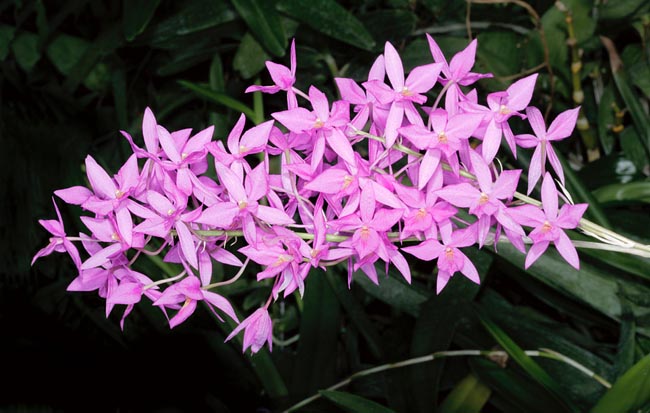Family : Orchidaceae

Text © Pietro Puccio

English translation by Mario Beltramini

The Barkeria melanocaulon is a fairly rare miniature orchid with showy 16 cm inflorescences © Giuseppe Mazza
The species is native to Mexico (Oaxaca), where it preferably lives on calcareous rocks in open forests around the 1600 m of altitude, in zones characterized by a humid warm climate in summer and cool and dry in winter.
The genus is honoured to the English collector George Barker (1776-1845); the name of the species is the combination of the Greek terms “mélanos” = black, and “kaulós” = caulis, stem, with reference the blackish base of the pseudobulbs.
Common names: dark-stemmed barkeria (English).
The Barkeria melanocaulon A.Rich. & Galeotti (1845) is a lithophytic orchid, epiphytic at times, with up to about 16 cm long erect pseudobulbs, thin and fusiform, with numerous exposed roots and 2-6 deciduous coriaceous leaves, distischous and alternate, ovato-lanceolate, 6-7 cm long and about 2 cm broad.
The inflorescences are terminal, racemose, up to about 16 cm long, with 3 to 20 inodorous flowers, of about 3 cm of diameter, long-lasting, two months about. The sepals and the petals are ovate, with pointed apex, lilac pink; the labellum, heart-shaped, has at its centre three keels (protrusions shaped like the keel of a vessel), yellow with purple dots, the column, about 1 cm long, has the central part pink spotted of purple and two fleshy and greenish wings, spotted of dark purple. It reproduces by seed, in vitro and by division.
Fairly rare miniature orchid, it requires medium temperatures, 18-26 °C, and frequent waterings and nebulisations in spring-summer, during the vegetative period, more spaced in winter, during the resting time, with night temperatures around the 10-14 °C; adequate ventilation is important.
The position must be much luminous, even slightly filtered sun; it may be mounted on a cork raft or on portions of branch, possibly with some sphagnum at the base, or placed in pot with medium sized bark and fragments of charcoal or rock.
For the waterings and the nebulisations is to be used rainwater, or water obtained by reverse osmosys or demineralized; the fertilizations, appropriately distributed in way to avoid salts accumulations, are to be done preferably with balanced water-soluble products, with micro-elements, by half dosage, or less, than what suggested on the packaging.
This species is inserted into the appendix II of the CITES (species whose trade is internationally ruled).
Synonyms: Epidendrum melanocaulon (A.Rich. & Galeotti) Rchb.f. (1862); Barkeria halbingeri Thien (1973).
